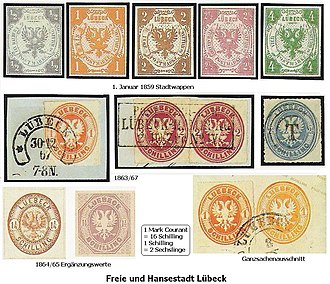Postal history and stamps of Lübeck

After the founding of the German Hanseatic League (1241), regular messenger trains soon formed. In Lübeck, the mediation of the correspondence was under the supervision of the commercial college of the Schonenfahrer , who also appointed the messenger (postmaster) and the other staff.
Around 1579 the taxissche Reichspost came to Lübeck, it existed alongside the Hansepost, there was friction. In 1683 the Platensche , later the Hanover (until 1844) and the Wismarsche post office were added. This went on together with the Danish post in the Schütting- Post.
During the French period , Napoleon united the three Hanseatic cities and north-western Germany as the Département des Bouches de l'Elbe with France by decree of December 13, 1810. It was the time of the continental lockdown against Great Britain.
The Schonen drivers took over the postal service again. The administration of the post office now worked for the account of the city treasury. The Schonenfahrer received an annual remuneration of 2,000 Mark Lübeck Courant .
In 1848 in Lübeck, in addition to the city post office, there was a taxi mail, Mecklenburg, Hanover (until 1845) and Danish riding and traveling posts as well as a Prussian post agency .
When the post of deputy in the postal department had to be filled in 1850, on April 1, 1851 the election fell on the postmaster of the Grand Ducal Mecklenburg-Strelitz, Hermann Lingnau , who received the title of postal director. The sub-officials were called the Litzenbrüder .
At the Postal Congress in Berlin (1851) a contract was signed between Lübeck and Thurn und Taxis on January 1, 1852, which precisely defined the competencies. The Danish Post Office proceeded in a similar manner. The construction of the Lübeck-Büchener railway is allowed and in return the royal Danish upper post office in Lübeck is allowed.
When the postal system was transferred to the North German Confederation on January 1, 1868, the city post office became the upper post office in the northern German postal district and Hermann Lingnau became the upper post director. The Danish post office and Thurn und Taxis closed their posts. In Lübeck there were two stable post offices and 7 letter collections for 50,339 residents. The mark Lübeck Courant = 16 Schillingen was used , whereby 1 Schilling corresponded to 2 sextuplets.
Postage stamps
Postage stamps were introduced on January 1, 1859. They show a double-headed eagle with outspread wings. On a band surrounding the eagle, one reads “postage stamp” and the indication of the value in letters. On the upper side is the word “Lübeck” and in the four corners a number indicating the value of the brand. The stamps from 1863 show the same eagle in oval in relief, above the word “Luebeck” on the sides the value and below “ Schilling ”. The postal stationery envelopes were the same as the postage stamps in terms of features and price.
Lübeck postage stamp of the stamp series 1859 as a motif of a postage stamp from 1959 of the Deutsche Bundespost
literature
- BE Crole: History of the Deutsche Post . II edition. Verlag W. Malende in Leipzig, Leipzig 1889. The author is Bruno Emil König from Berlin.
- Wilhelm Kähler: The Lübeck postage stamps. In: Der Wagen 1960, pp. 56–59.




